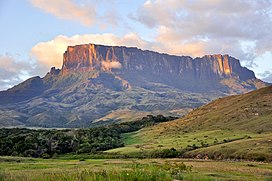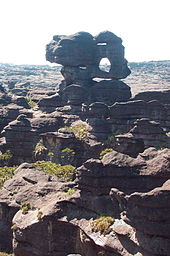Tepui
| Tepui | |
|---|---|
 | |
 Ecoregion territory (in purple) | |
| Ecology | |
| Realm | Neotropical |
| Biome | tropical and subtropical moist broadleaf forests |
| Borders | |
| Geography | |
| Area | 50,675 km2 (19,566 sq mi) |
| Countries | |
| Conservation | |
| Conservation status | Relatively stable/intact[1] |
| Protected | 37,658 km2 (74%)[2] |
A tepui
Tepuis tend to be found as isolated entities rather than in connected ranges, which makes them the host of a unique array of
Morphology





These
There are 115 such mesas in the
Tepuis range in elevation from 1,000–3,000 metres (3,000–10,000 ft).[5] The total surface area of all 115 tepuis is approximately 5,000 km2 (2,000 sq mi).[6]
Because of their great age, some tepuis exhibit surface features and caves typical of
Flora and fauna
The plateaus of the tepuis are completely isolated from the ground forest, making them
The tepuis are often referred to as the
It has been hypothesized that endemics on tepuis represent
The tepuis, also known as 'islands above the rainforest', are a challenge for researchers, as they are home to a high number of new species that have yet to be described.[10] A few of these mountains are cloaked by thick clouds for nearly the entire year. Their surfaces could previously only be photographed by helicopter radar equipment.
Many tepuis are in the
Selected tepuis
A few of the most notable of the 60 tepuis:[11]
- Auyantepui is the largest of the tepuis with a surface area of 700 km2 (270 sq mi). Angel Falls, the highest waterfall in the world, drops from a cleft in the summit.
- meet on the top.
- Matawi Tepui, also known as Kukenán, because it is the source of the Kukenán River, is considered the "place of the dead" by the local Pemon Peoples. Located next to Mount Roraima in Venezuela.[citation needed]
- Autana Tepui stands 1,300 m (4,300 ft) above the forest floor. A unique cave runs from one side of the mountain to the other.
- Sarisariñama Tepui, famous for its almost perfectly circular sinkholes that go straight down from the mountain top – the largest such sinkhole is 300 m (1,000 ft) in diameter and depth (purportedly created by groundwater erosion). They harbour an ecosystem composed of unique plant and animal species at the bottom.[7]
- Ilú-Tramen Massif is the most northerly mountain in the chain that stretches along the Venezuelan-Guyana border from Roraima in the south.
Popular culture
The hypothesis that endemic fauna and flora of tepuis represent remnants of ancient species was an inspiration to
In the 1990 film Arachnophobia, a new species of spider with a highly potent, deadly venom that lives in social colonies and is the implied apex predator of its environment is discovered in a sinkhole enclosed by a tepui in the Venezuelan rainforest, also alluding to the unique ecological conditions of tepuis.
Much of the story of 2009
In the novel The 6th Extinction (2014)[13] by James Rollins, a tepui in the north of Brazil was featured as a secret lair for the villain Dr. Cutter Elwes.
The sinkholes
See also
- Canaima National Park – National park in Venezuela
- Geography of South America – Overview of the geography of South America
- Plateau – Highland area, usually of relatively flat terrain
References
- Citations
This article needs additional citations for verification. (December 2011) |
- ^ "Tepui". Terrestrial Ecoregions. World Wildlife Fund.
- ^ Eric Dinerstein, David Olson, et al. (2017). An Ecoregion-Based Approach to Protecting Half the Terrestrial Realm, BioScience, Volume 67, Issue 6, June 2017, Pages 534–545; Supplemental material 2 table S1b. [1]
- ISSN 1179-3163. Retrieved 11 April 2018.
- ^ It’s Not So Lonely at the Top: Ecosystems Thrive High in the Sky
- ^ "Tepuis". Terrestrial Ecoregions. World Wildlife Fund. Retrieved 2012-03-13.
- .
- ^ a b Zimmer, Carl. It’s Not So Lonely at the Top: Ecosystems Thrive High in the Sky, The New York Times website, May 7, 2012, and published in the New York edition, p. D3 on May 8, 2012.
- ^ Chapman, F. M. (1931). "The upper zonal bird-life of Mts. Roraima and Duida". Bulletin of the American Museum of Natural History. 63: 1–135.
- S2CID 205783918.
- ^ "Conquering a virgin Venezuelan tepui, The Sunday Times; November 2007". Timesonline.co.uk. Retrieved 2012-03-13.
- ^ "The Carnivorous Plant FAQ: Heliamphora ranges and tepuis". Sarracenia.com. Retrieved 2012-03-13.
- ^ "Conquering a virgin", The Times, 11 November 2007
- ISBN 978-0-06-233698-9.
- Bibliography
- Much of the text of this article comes from the corresponding German-language Wikipedia article, retrieved on 16 February 2006, which uses the following sources:
- Uwe George: Inseln in der Zeit. GEO - Gruner + Jahr AG & Co., Hamburg, ISBN 3-570-06212-0.
- Roland Stuckardt: Sitze der Götter. terra - Heft 3/2004, Tecklenborg Verlag, Steinfurt.
- Uwe George: Inseln in der Zeit. GEO - Gruner + Jahr AG & Co., Hamburg,
- National Geographic Magazine, May 1989, "Venezuela's Islands in Time," pp. 526–561
External links
- The Making of the Tepuis Film : "The Living Edens : The Lost World"
- Mongabay.com – pictures from Tepuis in Venezuela.
